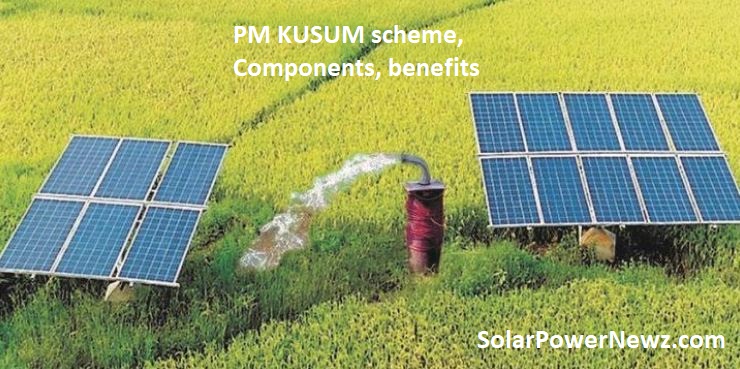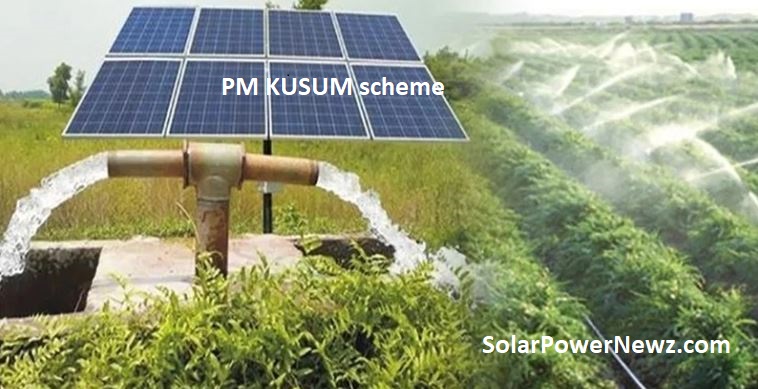In this article we will discuss about PM KUSUM scheme, Components, benefits. The Ministry of New and Renewable Energy (MNRE) has announced the Pradhan Mantri Kisan Urja Suraksha evem Utthan Mahabhiyan (PM KUSUM) Scheme for farmers in the country to instal solar pumps, as well as grid-connected solar and other renewable energy installations.

Table of Contents
The project aims to instal 25,750 MW of solar and other renewable capacity by 2022, with a total federal financial support of Rs. 34,422 crore (including service costs to implementing agencies). The plan has been extended till 31 March 2026.
Scheme Components

The Scheme is made up of three parts:
- Component A: 10,000 MW of decentralised ground-mounted grid-connected renewable power plants with individual plant sizes ranging from 2 MW to 10 MW.
- Component B: The installation of 17.50 lakh standalone Solar Powered Agriculture Pumps with individual pump capacities ranging from 7.5 HP to 10 HP.
- Component C: Solarization of tens of thousands of grid-connected agriculture pumps with individual pump capacities ranging from 7.5 to 7.5 HP.
The following changes have been made to the plan throughout its extended term beyond 2022 and until March 2026.
- Quantity transfers between Components B and C are permitted.
- Individual farmers in the North Eastern States, UTs of Jammu & Kashmir and Ladakh, and the states of Uttarakhand and Himachal Pradesh will be eligible for Central Financial Assistance (CFA) under Components B and C of the Scheme. The CFA for pumps up to l5 HP, on the other hand, will be limited to 10% of total installations.
- The condition or domestic content criterion for solar cells has been lifted for feeder level solarization projects awarded by the implementing agency on or before 20.06.2023.
- Before accessing extra-budgetary resources, the budgetary allotment of Rs. 10,000 Crore sanctioned by CCEA would be used.
Scheme implementation
MNRE’s State Nodal Agencies (SNAs) will work with States/UTs, Discoms, and farmers to implement the programme.
Components A and C of the Scheme will be implemented in Pilot mode until December 31, 2019. Component B, an ongoing sub-program, will be implemented in its entirety without going through pilot mode. Following the successful execution of the Scheme’s Components A and C pilot runs, these components would be scaled-up, subject to requisite permission.

Component A:
- Individual farmers, groups of farmers, cooperatives, panchayats, and Farmer Producer Organizations will put up renewable power plants with capacities ranging from 500 kW to 2 MW (FPO). If the above-mentioned entities are unable to get the equity required to establish the REPP, they may choose to construct the REPP through a developer or even a local DISCOM, which will be regarded RPG in this situation.
- DISCOMs will alert substations of surplus capacity that can be fed into the grid from such RE power plants and will welcome applications from interested beneficiaries to put up the renewable energy plants.
- The generated renewable energy will be acquired by DISCOMs at a feed-in-tariff (FiT) set by the relevant State Electricity Regulatory Commission (SERC).
- For a period of five years from the COD, DISCOM would be eligible for PBI at Rs. 0.40 per unit purchased or Rs. 6.6 lakh per Mega Watts of capacity installed, whichever is less.
Component B:
- Individual farmers will be assisted in installing standalone solar Agriculture pumps with capacities of up to 7.5 HP (15 HP over the extended scheme period).
- A CFA of 30% of the benchmark cost or the tender cost, whichever is lower, will be provided. The State Government will pay a 30% subsidy, with the farmer providing the remaining 40%. Bank financing may be made available for farmer contributions, so that the farmer pays only 10% of the cost up front and receives up to 30% of the cost as a loan.
- CFA of 50% of the benchmark cost or tender cost, whichever is lesser, of the stand-alone solar pump would be granted in the North Eastern States, Sikkim, Jammu & Kashmir, Himachal Pradesh and Uttarakhand, Lakshadweep and A&N Islands. The State Government will pay a 30% subsidy, with the farmer providing the remaining 20%. Bank financing may be made available for farmer contributions, requiring the farmer to pay only 10% of the cost up front and the remaining 10% as a loan.
Component C:
- Individual farmers with grid-connected agriculture pumps will be assisted in solarizing their pumps. The concept allows for solar PV capacity of up to double the pump capacity in kW.
- The farmer will be able to use the solar power generated to suit his or her irrigation demands, and any extra solar power will be sold to DISCOMs.
- CFA of 30% of the benchmark cost or the tender cost, whichever is smaller, will be provided for the solar PV component. The State Government will pay a 30% subsidy, with the farmer providing the remaining 40%. Bank financing may be made available for farmer contributions, so that the farmer pays only 10% of the cost up front and receives up to 30% of the cost as a loan.
- CFA of 50% of the benchmark cost or the tender cost, whichever is lower, of the solar PV component would be granted in the North Eastern States, Sikkim, Jammu & Kashmir, Himachal Pradesh and Uttarakhand, Lakshadweep and A&N Islands. The State Government will pay a 30% subsidy, with the farmer providing the remaining 20%. Bank financing may be made available for farmer contributions, requiring the farmer to pay only 10% of the cost up front and the remaining 10% as a loan.
Scheme benefits
The project will provide rural landowners with a steady and ongoing source of income for the next 25 years by utilising their dry/uncultivable land. Furthermore, because the solar panels will be positioned above a specific height, farmers will be able to continue growing crops if cultivated fields are chosen for solar power project installation.
The system would ensure that there is enough local solar/other renewable energy-based electricity available to feed rural load centres and agriculture pump-set loads, which are largely powered during the day. Because these power plants will be positioned closer to agricultural loads or electrical substations in a decentralised manner, transmission losses for STUs and Discoms will be decreased. Furthermore, the plan will assist Discoms in meeting the RPO target.
Solar pumps will save farmers money on diesel for running diesel pumps and provide a reliable source of irrigation through solar pumps, in addition to reducing hazardous emissions from diesel pump operation. Given the long wait for an electric grid connection, this initiative will assist 17.5 lakh farmers over a four-year period while without adding to system burden.